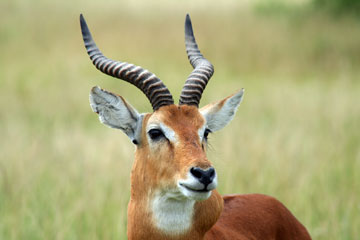Mammals in war-torn Virunga National Park recovering finds WCS survey
Mammals in war-torn Virunga National Park recovering finds WCS survey
Wildlife Conservation Society
June 20, 2006
A recent wildlife census conducted in Virunga National Park in the Democratic Republic of Congo (DRC) revealed that several species of large mammal are now recovering from a decade of civil war and rampant poaching, according to the Wildlife Conservation Society (WCS) and the Institut Congolais pour la Conservation de la Nature (ICCN). Specifically, elephants and other species in the park have increased in number since the park’s last census, due in large part to the anti-poaching efforts of park guards who patrol this World Heritage Site at great personal risk.
“The results of the census are encouraging, and proof that protecting the park’s wildlife can be done in the most turbulent conditions,” said WCS researcher Deo Kujirakwinja. “Poaching is still taking a toll on wildlife and the rate of recovery is being slowed as a result, but it is clear that the efforts of ICCN and its partners are finally leading to a reduction in the level of poaching.”
Established in 1925, Virunga National Park remains the most species rich park in Africa and once boasted the highest density of large mammals in the world before a wave of unrest and poaching descended upon the region. Since the 1960s, the park’s populations of elephants, hippos, and buffalos have declined dramatically, with the heaviest levels of poaching occurring in 1980s and during the past 10 years since the beginning of the country’s civil war in 1996. For instance, the park’s once abundant elephant population—estimated at 4,300 in the 1960s—had been reduced to a few hundred individuals by 2003.
The most recent census—conducted between 9-12 June 2006 and funded by the US Fish and Wildlife Service—found that efforts to protect the park’s wildlife seem to be reversing this trend of decline, and that most of the park’s large mammals have increased in number since the last census in 2003. Elephants have increased to 340 individuals from 265 in the past three years. The census also found approximately 3,800 buffalo (up from 2,300 in 2003). Uganda kob—a species of antelope—now number nearly 13,000, almost the same level for the species before significant poaching began in the 1960s.
 Uganda Kob. Photo by Rhett Butler. |
Efforts to curb poaching have come with a high cost over the past few years. Over 100 park guards in Virunga Park have been killed since 1996 while trying to prevent poaching, and one was killed as recently as May 2006. Currently, park guards receive only $1 per month as a salary from the government, although this amount was recently increased up to $30 per month with funds from UNESCO from 2002-2005. Additional support for the park guards will come from the European Union through the Zoological Society of London in the near future.
Virunga National Park has been the major destination for tourists in the DRC since it was created, but recent unrest over the past decade has resulted in a decrease in tourism dollars as well as wildlife. Tourism in the region has the potential to generate significant revenues for the parks and the country. In Uganda, Kenya, and Tanzania, the tourism business has generated millions of dollars, not only for the parks but also for local communities throughout the region.
“Virunga Park will be the key to any tourism industry in Congo with its large mammals, gorillas, active volcanoes and biodiversity. It is clear that Congo needs to invest in the future of this park if they are to realize any of the benefits of tourism in future,” said Dr Andrew Plumptre of the Wildlife Conservation Society. “It is also clear that park guards will need continued support if the park is to show an increase in the large mammal populations in future.”
This article is a modified news release from Wildlife Conservation Society.